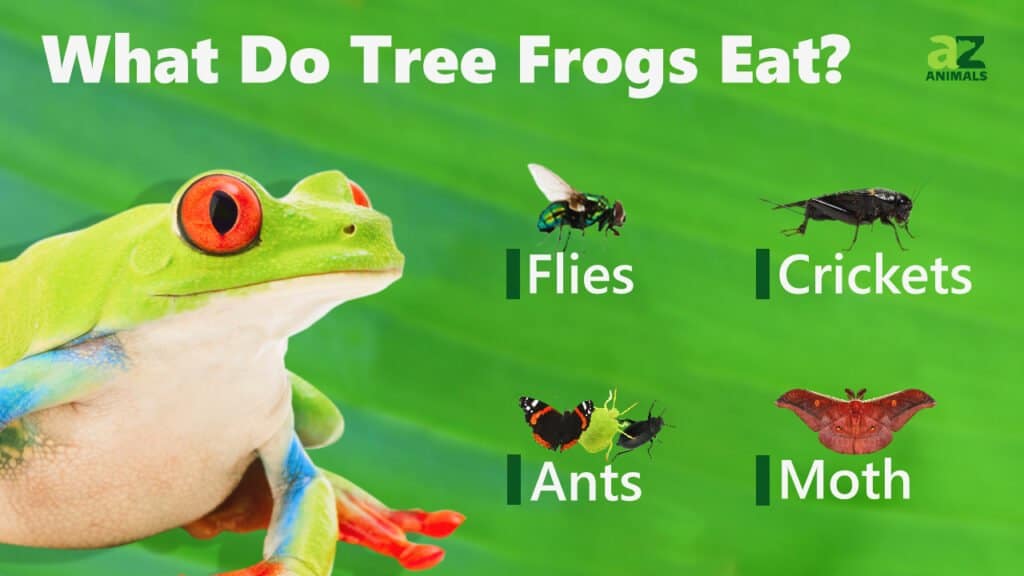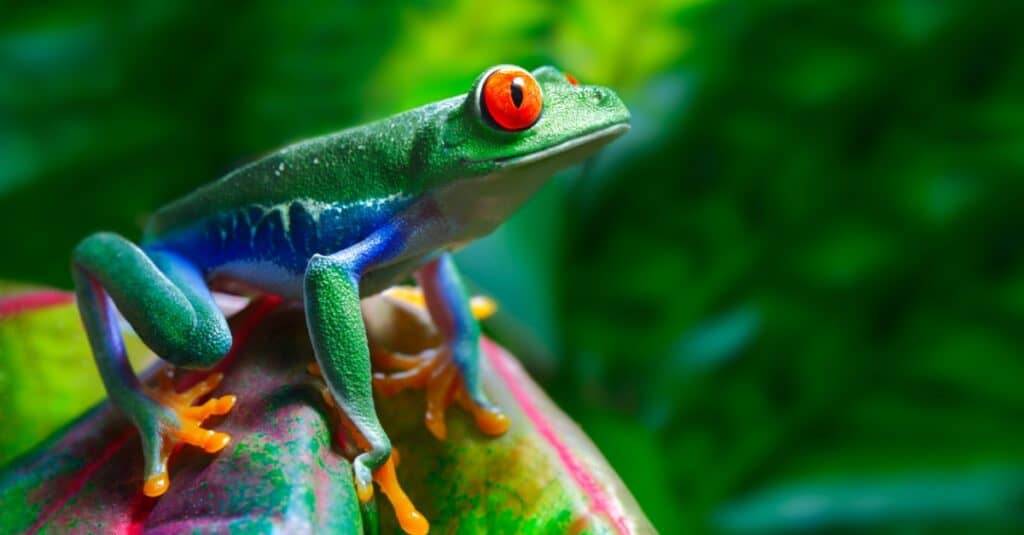
- A viscoelastic tongue and adhesive toepads make them excellent hunters.
- Although they are mainly insectivorous, certain of them are not averse to attacking and devouring other tree frogs, as well.
There are over 700 different species of tree frog in existence — and while they can vary pretty significantly in terms of both physiology and habits, their shared ancestry ensures that most of them enjoy similar diets and employ similar methods of hunting prey and evading predators. They also share similar ecosystems — because while tree frogs are present on every continent other than Antarctica, over 75% of them are native to Central and South America. Not every species of tree frog spends the majority of their time in trees, but their dietary and hunting habits were developed explicitly for survival in the rainforest. Despite this specificity, some tree frogs have adapted to live in or near marshes, lakes, or ponds where trees aren’t as plentiful.
Most adult tree frog species are insectivores with opportunistic feeding patterns — adjusting their diets to accommodate environmental availability but feeding exclusively on insects and other invertebrates with a rare few exceptions. The American green tree frog is dispersed throughout major portions of the United States, and the swampy habitats they prefer to result in diets rich in mosquitos and flies. The gray tree frog is a close relative to the green tree frog that can be found in Missouri. Ants make up roughly 40% of their diet, while beetles constitute about 30%. Like the green tree frog, the distinctive and iconic red-eyed tree frog has a rich diet of flying insects that include flies, moths, and grasshoppers. The red-eyed tree frog also sometimes cannibalizes smaller frogs — a habit that’s shared with invasive species like the Cuban and Japanese tree frogs but one that’s not shared by the gray tree frog.
The adult tree frog may be a pure insectivore, but baby frogs need to work their way up to that. Tadpoles will typically feed on a diet of algae and other aquatic plants. As they grow from their baby stage into adulthood, they’ll begin to adopt a more carnivorous diet. Vegetable matter is both small enough for them to easily consume and rich in vitamin C that they need to grow to adulthood.
What Do Tree Frogs Eat in Captivity vs in the Rainforest?
Environmental variables have led to different tree frogs having slightly different diets, but these distinctions are much less important for pet frogs. Whether you have a pet gray tree frog or a red-eyed tree frog, the food to feed them is going to be essentially the same. Pet tree frogs in captivity should be fed an exclusive insectivore diet. Crickets and grasshoppers are popular food choices because they’re readily available in pet supply stores and are high in protein. Bait worms are also popular choices, and a varied diet is best for these opportunistic insectivores.
Regardless of species, most tree frogs eat a diet that includes:
- Flying insects (flies, moths, crickets)
- Terrestrial insects (beetles, ants)
- Plankton and algae (as tadpoles)
- Worms (mealworms, waxworms)
- Smaller frogs (rare species)
How Do Tree Frogs Hunt For Food?

©Brandon Alms/Shutterstock.com
Now we’ve explored the answers to the question, “what do tree frogs eat?” in detail, it is time to take a look at just how they get their food. As with most other frog varieties, tree frogs rely on their incredible tongues to catch prey. Frog saliva can function as both a solid and a liquid, and that lends it an incredible sense of adhesion and can operate at speeds of up to four meters per second. It’s an incredibly effective tool for hunting down insects, but the tree frog is further assisted by their adhesive feet. The pads on their toes are filled with fluids that help them stick to surfaces, and they can adjust to accommodate a wide variety of different textures by adjusting the grip of their long toes. Arboreal tree frog species take advantage of these skills to get close to getting hunting spots and within reach of flying prey.
Tree frogs have exceptional eyesight that functions well at night. Naturally, they operate as nocturnal hunters. Their forward-facing eyes give them a narrower field of view but allow them to follow insects more closely and strike with precision. The primary factor in what insects end up dinner and which getaway comes down to how much they move. The American green tree frog, in particular, tends to prioritize frequently moving prey over larger prey — suggesting that motion is the primary trigger for an attack. That’s a smart evolutionary adaptation considering that frogs can’t chew and need to swallow their prey whole. There’s even some evidence that frogs have developed a preference for specific prey based on their movement patterns — a possibility reflected in the fact that the green frog prioritized common flies over four different mosquito species.
What Animals Eat Tree Frogs?
Having explored the topic “what do tree frogs eat?” in depth, it is only natural to explore what loves to eat these arboreal amphibians too.
Being nocturnal also helps tree frogs elude potential predators, of which there are many. Arboreal tree frogs are often targeted by any number of different bird species ranging in size from blue jays to hawks and owls. Species that live in or near water can sometimes find themselves hunted by larger fish. Tadpoles and baby tree frogs are especially prone to aquatic predation, and many species are in the habit of only laying eggs in bodies of water without fish. All species have to reckon with mammals, snakes, and reptiles.
In the rainforest, frogs are most at risk while traveling to breeding sites as this requires them to venture out onto open earth. Common mammalian threats include squirrels, raccoons, and otters — all creatures that combine tremendous dexterity with above-average eyesight. While many of these predators can climb trees, many tree frog species possess camouflage that gives them the upper hand in treetop canopies. Other tree frog species take an opposite tact and bear bright and vibrant colors. These can either be a warning to predators that the frog is poisonous or an attempt to confuse their sense of vision.
Perhaps the most dangerous threat to tree frogs are snakes like the tree boa and rat snake. These serpents are strong climbers who can track the chemicals a frog leaves behind. Humans don’t eat any tree frog species, but they do contribute to habitat destruction and capture them to be sold in captivity. The tree frog pet trade has led to the spread of invasive species like the Japanese tree frog.
Up Next…
Keep reading these posts for more incredible information about key animal facts.
- What Eats Snakes? 10 Animals That Eat Snakes: A fearsome reputation makes it difficult to imagine them as prey. But they are. Read about the animals which consider them just that.
- What Do Snapping Turtles Eat? They’re aggressive and will go after what they want. Find out what vanishes between those snapping jaws.
- What Do Axolotls Eat? Their innocuous appearance notwithstanding, these underwater chameleons are strictly carnivorous. Discover their favorite prey here.
The photo featured at the top of this post is © iStock.com/Linas Toleikis
Thank you for reading! Have some feedback for us? Contact the AZ Animals editorial team.






